In New York, there is the Department of Environmental Conservation (DEC). Pennsylvania has its Department of Environmental Protection (DEP). Texas has the Texas Railroad Commission (TRC). All three agencies are tasked with overseeing oil and gas drilling as well as the environment. The problem comes when one part of their job is eclipsed by the other. One of the big goals is to make money for the state through "responsible" drilling. But with money at a premium, the environmental part of the job gets short shrift every time. In Texas, it is even worse because the three Railroad commissioners are elected, not appointed. Their campaigns are funded big time by the energy corporations- the gas and oil industry.
A cursory investigation reveals that inspections are not done as required in many cases. Inspector positions are dwindling while wells are proliferating rapidly. Sometimes personnel doing inspections have absolutely no training in that field. In some cases, gas companies are allowed to do their own reporting, believe it or not. If they say there is no problem, or the problem has been fixed, the DEC or the DEP just accepts that as fact. Case closed.
Texas Railroad Commissioners Continue to Put Public at Risk tells the story of a North Texas rancher who is convinced that the pristine waters of the Brazos River are polluted due to contamination of the Seymour Aquifer that flows under his ranch. The contamination is being caused by an abandoned gas processing plant located just 400 feet from the river's edge.
Now before you dismiss this story, and say that Texas is far away and doesn't have any relevance to us here in Pennsylvania, just remember that Texas got the gas wells first and is much further along than PA and NY. However, we are living atop a much, much bigger shale formation than the Barnett ever thought of being, and the gas drillers are drooling over what they are going to get out of our land. As soon as drilling rigs in Texas become available, they are sent post haste to Bradford County and other areas of PA to be set up here. With the rigs comes the work force from Texas... They need the jobs, and the gas industry would rather keep them on rather than training a whole new work force.
It is very disillusioning to realize that environmental agencies of the government do not protect our waterways, our forests, our air, our beautiful vistas (those scenic views we pull off the road to see). They are in place primarily, though they would probably not admit it, to assist the gas industry. I'm not saying that there aren't some state employees who try to do their jobs and who care about the environment and public health. But the whole system is set up bassackwards in favor of gas drilling. This is not the way it should be, nor does it have to be. But it is the way it is being done right now. If you look at aerial photographs of some places in the west, it looks like a moonscape or a pin cushion. That is because the process of gas drilling starts small and becomes huge over time. According to Don Young of FWCanDo (Forth Worth), the two words to watch out for when dealing with the gas industry, are "FOR NOW." "This is all we want FOR NOW," they say. The landmen only tell you a tenth of what they know, and believe me, they know what you are in for. The leases only get you started on the path. Then you begin to see more and more: The additional wells drilled if a lot of gas is found in a particular place, the water pumping stations needed, the meter stations, the pipelines, the gas processing plants, the felling of trees, the sludge pits, the huge 80,000 pound trucks by the hundreds, the noise, the bright lights. All these things come with the territory, and no regulatory agency has the capacity to oversee it all. And, of course, the oil & gas industry is the only polluter that does not have to follow the Safe Drinking Water Act, the Clean Water Act, and other laws which protect us and the environment. In fact, there are less toxic ways of drilling and handling flowback water, and these methods are not being seriously considered at the moment because it is not the law.
WHEN GAS DRILLING BEGINS, OR WHEN THE FIRST TRUCK APPEARS, WHEN SEISMIC TESTING OCCURS, WHATEVER IS HAPPENING, LANDOWNERS WILL HAVE TO BE THEIR OWN WATCH DOGS. MAKE SURE YOU HAVE A VIDEO CAMERA AND A DIGITAL CAMERA. DOCUMENT WHAT YOU SEE. EXPECT THAT AT SOME POINT YOU MAY HAVE TO GO TO COURT. THIS IS A BUSINESS, AND A FULL TIME ONE AT THAT. AS A LANDOWNER, YOU DON'T GET A SECRETARY AND AN INSPECTOR, AND A LAWYER, FOR THAT MATTER, TO ASSIST YOU AT YOUR END.
Thanks to http://txsharon.blogspot.com whose stellar reporting helped me with this post.
A Little Splashdown Addendum "For Now"
The Winter 2008 issue of 'Nature Conservancy' magazine's article Proving Ground, by Rebecca Huntington, offers a fine example of the incremental encroachment that takes place when the gas drilling invaders arrive.
"People in Wyoming have seen plenty of energy booms in their lives, but [the Jonah Field] ushered in a new era. Jonah has become the poster child for energy development gone awry. Just the name has become a catch-phrase for industrialization of the Western landscape.
From above, the sagebrush plains now look pockmarked; Jonah is said to resemble a rabbit warren.
 There, what started a decade ago as a proposal for 500 natural gas wells spaced 80 acres apart has ballooned into a plan for 3,100 wells, known as the Jonah Infill Project.
There, what started a decade ago as a proposal for 500 natural gas wells spaced 80 acres apart has ballooned into a plan for 3,100 wells, known as the Jonah Infill Project. Jonah sits of a patch of sage owned by the public and overseen by the U.S. Bureau of Land Management (BLM). ...
In 2006, the BLM approved the infill plan; the wells are spaced just 10 acres apart. Meanwhile, the Pinedale Anticline, to the north, has developed in lockstep with Jonah, albeit with an even bigger proposal for more than 4,000 additional gas wells. ... That field will bring even more roads, and Jonah alone could yet see up to 465 miles, along with the traffic that accompanies drilling up to 250 wells in peak years. ...
Pinedale, some 30 miles north of Jonah, doesn't have a single traffic stoplight, yet during a few days last winter, the town experienced air quality on a par with Los Angeles, in large part because of drilling activities in Jonah and the Anticline. To some people in Pinedale, the initial plan at Jonah was the equivalent of the camel sticking its nose under the tent. They never saw the rest of the body coming. "It was such a rush. It happened before anybody realized how much damage was actually occurring," said Linda Baker, a community organizer for the Upper Green River Valley Coalition in Pinedale."
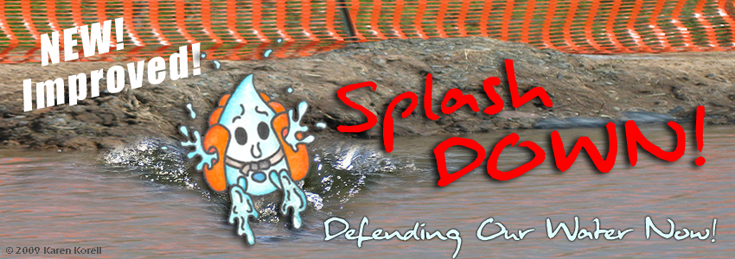



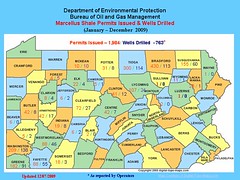

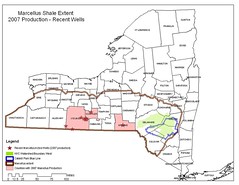

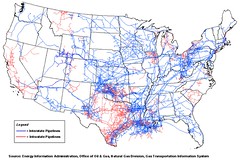
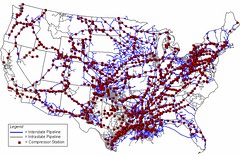









No comments:
Post a Comment